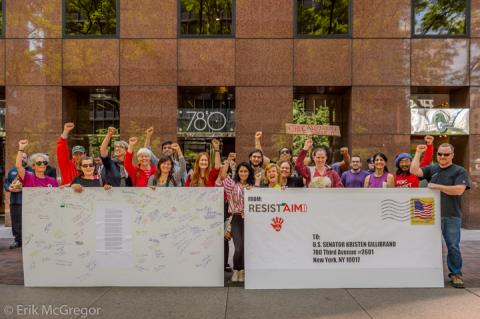On a Saturday afternoon in the New York City suburb, Ossining, N.Y., Bette Ann Jaster, OP sits in the chapel at Mariandale Retreat and Conference Center. The priest is preaching about the baptism of Jesus, in which Jesus was invited by John to come to the water. As she listens, Jaster, a Dominican Sister of Hope, can't help but hear his words literally.
At the time, media sources were spilling the news that the Flint, Mich., water was toxic. Jaster reflected on the fact that, for over a year, the water flowed steadily to residents, hospitals, and businesses following a switch in their supply from Lake Huron to the Flint River to save money.
"This is all the water for drinking, bathing, cleaning, manufacturing, and it is toxic with high levels of lead," she says. "Now, children experience lead poisoning on a grand scale, facing stunted growth, drops in IQ and behavior issues. How can they come to the water?"
Water is an especially pertinent topic for Jaster. A community organizer since 1985 and a non-profit co-founder in 1999, she's participated in three rallies just in the past week to oppose the Algonquin Pipeline (AIM, Algonquin Incremental Market). The pipeline, which is 42 inches in diameter, is currently being dug from Stony Point in Rockland County under the Hudson River to a space 105 feet from significant critical infrastructure at Indian Point Nuclear Power facility. Jaster, along with many others, feel that the procedure presents serious danger.
EM-160523-ErikMcGregorPhotography-001.jpg

In community with other activists, Jaster has studied fracking and its effects for years. She's now a member of the Resist AIM Pipeline advocacy group, which facilitates learning about and actions against the pipeline.
This past Monday, she stood with other members of Resist AIM outside of Sens. Chuck Schumer and Kirsten Gillibrand's New York offices. She helped transport and present seven-by-four-foot letters signed by "hundreds of New Yorkers" that demanded an immediate halt to the pipeline.
Days earlier, Jaster joined the group at an action in Peekskill's Blue Mountain Reservation. While there, the group sang, chanted, and listed reasons as to why the pipeline is a bad idea. As a speaker read each bullet point, the group repeated it en masse, allowing their voices to amplify. Jaster spent the afternoon speaking with various members of the press to offer a new view on environmental advocacy: protecting and preserving Earth as a sense of belonging to and building to a universal community.
For Jaster, community isn't only activists, Catholics, or even humans.
"We want to enlarge our sense of community to include the natural world, the land, organisms, animals, water, air, stars, and all of us, both near and far," she said. "We as people might have different views of spirituality, but we all are citizens of the planet.”
"We only have so much water on the planet," she continued. "Where are we going to get water if we're permanently damaging it with these procedures? We have to care not just about the money but also about the repercussions down the line."
This isn't Jaster's first brush with environmental advocacy. In 1996, she co-founded the Denver nonprofit Earthlinks, which provides a work program for people who are homeless and low-income to learn skills and create Earth-friendly products that sustain people and the planet. In addition to fostering work skills within the Earthlinks community, she often took participants on various nature-related field trips. One afternoon, while bringing a group to the National Renewable Energy Laboratory, Jaster gained a new view of Earth.
"Here I am with homeless people, and the Lab was showing us a projection of Earth that highlighted areas of drought over the course of years," she explained. "The drought would increase and flooding would decrease, and you saw the beige on the map increasing and going away. As I watched, I got the feeling that the planet was breathing. I saw it in a whole different way. It gave me a deep understanding of Earth as a living organism."
Now a resident of Rye Brook, N.Y., Jaster has carried this understanding and passion to the East Coast. In 2015, after she led a successful effort to change legislation in the Village of Ossining to allow for beekeeping, Mariandale welcomed two hives of bees.
Whether it's specifically about bees or water, Jaster believes that protecting and preserving Earth is a kind of prayer.
"The natural world is all signs of God," she said "Jesus came to bring people together and to stand for justice. God created heaven and Earth and wanted people to live life abundantly. People cannot live abundantly when all of creation is being threatened."
Living abundantly is, of course, living justly. This means without gigantic leaks of methane gas like those that frequently occur around burst pipelines ("Animals are dying, people of all ages are nauseous, have nosebleeds, rashes, their eyes burn, so on," Jaster lamented). This means without anyone leaving a home in fear, wondering if they will ever return. This means providing each other with of a sense of belonging, and offering means for everyone to support their families. ("Many learn how to kill, taking their imagination, their dreams, and hopes to a new battlefield," Jaster said. "They find blood, not water.")
"The world and our God are crying out for each of us to wake up!" Jaster wrote. "There runs water and blood of all kinds in this world around us. Where, though, is the life-giving water? Perhaps it is in each of our own H2O, C02 and O2, the breath of life."
*Correction: An earlier version of this story misstated the pipeline's distance as 110 feet from the facility, and listed the incorrect city of residence for Sr. Jaster and date of Earthlinks founding.
Got something to say about what you're reading? We value your feedback!

